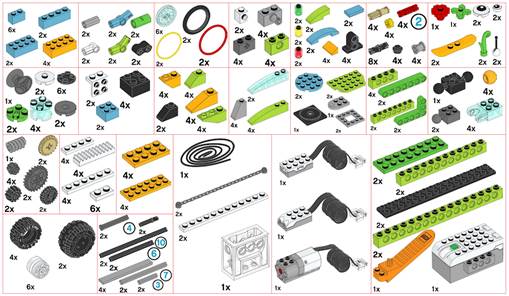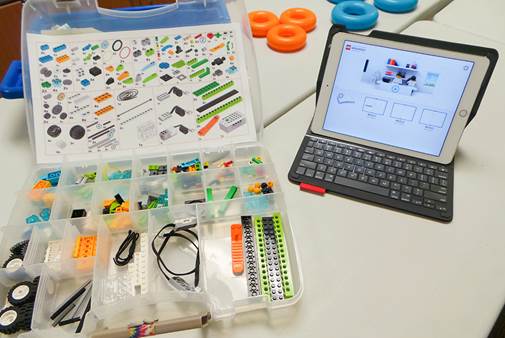 |
December 2017
|
December 2017 // Volume 55 // Number 6 // Tools of the Trade // v55-6tt10
Organizational System for the LEGO WeDo 2.0 Robotics System
Abstract
In this article, we explain an organizational system for the new LEGO Education WeDo 2.0 Core Set used in 4-H robotics; in school enrichment, afterschool, and other youth robotics programs; and by hobbyists. The system presented is for organizing WeDo parts into a translucent parts tray that includes part names and numbers. The article provides step-by-step instructions for obtaining needed materials and constructing the parts inventory card. The system allows for personalization of the parts card to facilitate equipment management.
Introduction
Electronic and programmable LEGO systems have been a boon to educational robotics programs conducted in 4-H, schools, and other youth programs (Barker & Ansorge, 2006; Ewers, 2010; Habib, 2012a, 2012b). However, one problem associated with the use of LEGO systems, especially in programs in which multiple kits are used, is that maintaining the kits can be taxing. If kits are incomplete, users find completing activities more difficult, and more time is spent looking for parts than attending to lesson learning objectives. An equipment management plan is critical for enabling program leaders and participants to focus on educationally meaningful activities, and a system for organizing parts is a key aspect of such a plan.
In 2016 LEGO released an updated version of its popular WeDo Robotics system. The new version, LEGO Education WeDo 2.0 Core Set, Part #45300, comprises updated electronics and software and includes some new parts. Accordingly, we present here an updated version of the previously published inventory system (Ewers & Dawes, 2013) to facilitate parts management for the LEGO Education WeDo 2.0 Core Set. As with the previous inventory system, the new system involves the use of a customizable parts key card and a sectioned translucent parts tray.
Understanding the Parts Key Card
Figure 1 shows the front of the prepared parts key card. This side of the card aligns with the compartments of the tray and indicates the tray location and quantity for each part type. Axel lengths as defined by LEGO are circled next to respective parts.
Figure 1.
Front Side of Parts Key Card for LEGO Education WeDo 2.0 Core Set: Parts Tray Map

Notes: Quantities of parts are indicated as #x.
The numbers in circles indicate part lengths (based on LEGO custom units for axel lengths).
Figure 2 shows the back of the parts key card, which contains a picture and name for each part type. The part name information is important for facilitating communication among participants.
Figure 2.
Back Side of Parts Key Card for LEGO Education WeDo 2.0 Core Set: Part Names

Note: The numbers in circles indicate part lengths (based on LEGO custom units for axel lengths).
Constructing the Parts Organization Tray
- Purchase a parts tray. (You will need one tray per WeDo 2.0 kit.)
There are many options for parts trays. The one we have found very functional for youths is the Plano Connectable Satchel Stowaway with Handle (Large), 5-22, Part Number 3870-01. The tray's dimensions are 15 in. long by 11.25 in. wide by 2.25 in. high (38.1 cm x 28.57 cm x 5.71 cm). The tray has adjustable compartments and a handle, which makes it easy for smaller persons to carry.
The Plano tray is available at sporting goods stores or online from many vendors, and the cost ranges from $7 to $15. - Obtain the parts key card.
Request the WeDo 2.0 Parts Key Card via email from author Suzann Hagan Dolecheck at sdolecheck@uidaho.edu.
The cards are available in pdf and Microsoft Publisher file formats. The Publisher file can be edited with Microsoft Publisher software, making this option useful if you want to include information such as your program name or a kit number on each kit. - Prepare the parts key card.
a. Compare the parts key card to your kit inventory to confirm that the parts named and numbers of parts are the same. If they are not, edit the card to match your set.
b. Print the parts key card in color on legal-sized paper, 8.5 in. by 14 in. (Note: It is possible to print the card on regular, letter-sized paper, but the layout will not align as directly with the tray compartments as it will if the card is printed on legal-sized paper.)
c. Prefit the card in the parts tray to identify borders to trim. Consider that lamination will add about ¼ in. (6 mm) to each border.
d. Add labels to the card as desired (e.g., kit number, name of kit owner).
e. Trim the printout to allow for the border that will be added during lamination.
f. Laminate the card, placing the two card sides back to back so that the parts tray map and the part names will be visible on opposite sides of the laminated card.
g. Cut away the excess laminate so that the card will fit inside the lid of the tray and will not inhibit the lid from closing. Do not cut the laminate too close to the paper or you will break the seal of the laminate. Round the corners and smooth the borders of the laminate to reduce sharp edges, which could cause cuts.
h. Place the card in the lid of the tray. Do not attach the card to the tray because doing so will hinder effective use of the card. When the set is open, the card may be placed under the tray to line up the compartments, or it can be used to examine the available parts. The card also may be flipped over to identify the name of a part.
- Prepare the parts tray.
a. Place the tray dividers in the tray to match the parts key card layout.
b. Label the tray to match the card if desired.
- Save the original LEGO plastic bin for use as a place to store projects between sessions.
Additional suggestions:
- Label each of the electronic parts (Smarthub and sensors) to indicate the kit in which it belongs. This action helps reduce the migration of parts to other kits.
- Remove the two AA batteries from the Smarthub when storing kits to reduce the incidence of damage from battery corrosion.
The time for assembling the parts tray is approximately 30 min. Again, the cost of the tray is approximately $7 to $15, and the cost for printing and laminating a card is $2.
Figure 3 shows the finished product with the LEGO Education WeDo 2.0 Core Set organized in the Plano parts tray. Notice that the parts key card acts as a map showing the location for each part type.
Figure 3.
LEGO Education WeDo 2.0 Core Set Kit Organized in Plano Tray with Parts Key Card

Conclusion
We have found in using this system that fewer parts are lost and that youths spend less time looking for parts and take much better care of the equipment. Additionally we have observed better use of the part names indicated on the cards. For example, compare "give me the wiggly thingy" to "hand me the universal joint connector." Choosing to use this organizational method facilitates improved communication among youths as well as facilitators and allows more time spent on activities.
References
Barker, B. S., & Ansorge, J. (2006). Using robotics as an educational tool in 4-H. Journal of Extension, 44(5), Article 5IAW6. Available at: http://www.joe.org/joe/2006october/iw6.php
Ewers, T. G. (2010). Idaho robotics opportunities for K–12 students: A K–12 pipeline of activities promoting careers in science, engineering, and technology. Journal of Extension, 48(1), Article 1IAW2. Available at: http://www.joe.org/joe/2010february/iw2.php
Ewers, T. G., & Dawes, K. (2013). No more missing LEGO parts: A simple inventory system that works! Journal of Extension, 51(4), Article 4TOT5. Available at: https://joe.org/joe/2013august/tt5.php
Habib, M. A. (2012a). Robotics competitions: An overview of FIRST events and VEX competitions. Journal of Extension, 50(3), Article 3IAW3. Available at: http://www.joe.org/joe/2012june/iw3.php
Habib, M. A. (2012b). Starting a robotics program in your county. Journal of Extension, 50(2), Article 2IAW6. Available at: http://www.joe.org/joe/2012april/iw6.php




